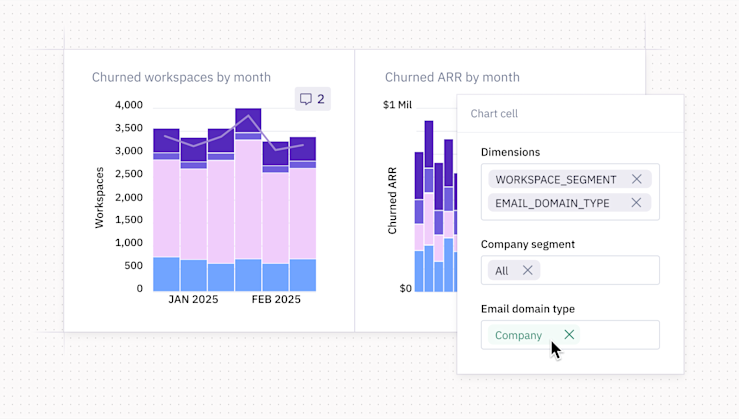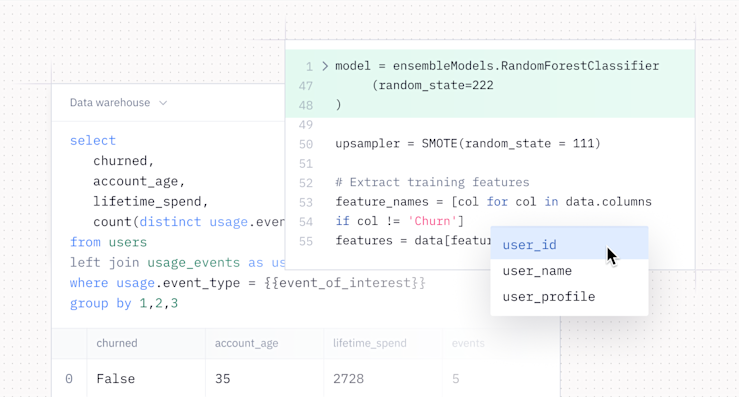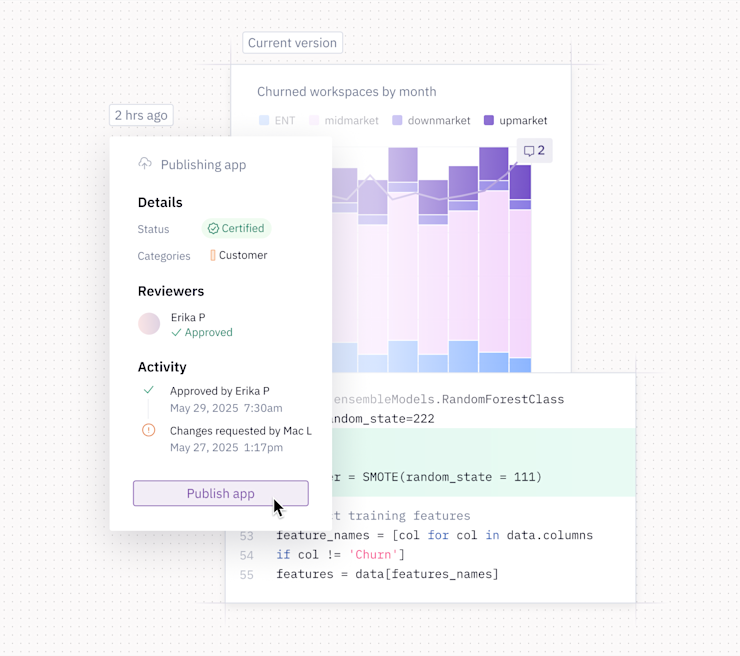Blog
How to build a data collaboration culture that drives better decisions
How to foster data collaboration across your team

Most of us spend more time wrangling data than actually using it. And even when the insights are there, aligning the right people around them can feel like herding cats (but with dashboards).
That’s where data collaboration can make all the difference. It’s more than just sharing numbers or commenting in a doc — it’s building a culture where data folks and their teammates can actually work together to solve real problems using their datasets and expertise.
Let’s talk about what that looks like, some classic pitfalls (and how to avoid them), and how the right tools (yes, we’ll talk about Hex) can make collaboration feel way less like chaos and way more like progress.
What is data collaboration anyway?
Data collaboration is when teams actively work together to explore, analyze, and act on data. This isn’t a handoff. It’s not “here’s the dashboard, good luck.” It’s back-and-forth, question-asking, insight-digging teamwork with everyone bringing their perspective to the table. And sure, some of it happens in real time, but asynchronous collaboration (paired with the right context and tools) can be just as powerful.
The difference is intentionality. Data collaboration is proactive. It means setting teams up with the culture, context, and workflows to contribute meaningfully — even if they’re not in the same meeting or time zone. In a strong data ecosystem, this kind of intentional collaboration turns scattered data assets into insights that drive action without endless meetings or PDF ping-pong.
How does data collaboration differ from data sharing?
We'll keep it simple:
Data sharing = “Here’s a link to a spreadsheet.”
Data collaboration = “Let’s jump in together and figure this out.”
The first is static. The second is dynamic — and frankly, way more useful!. Data sharing alone doesn’t unlock the full benefits of data collaboration. You need context, communication, and real-time alignment between stakeholders.
Examples of collaborative data workflows
So, what does collaboration actually look like in practice? There are a few flavors:
Data teams + business teams:
Your sales team wants to know why churn spiked last quarter. Don’t just send them a chart. Walk through the datasets together, ask new questions, and maybe even adjust the model live to optimize results and improve decision-making.

Working across tools and skill levels: Maybe someone’s working in Python, another in SQL, and your head of ops wants to see the results in a dashboard. True collaboration means everyone can contribute without friction so there’s no switching between platforms or manually stitching together workflows and pipelines. That might mean centralizing in one platform or using tools that connect environments — anything that cuts down on silos and manual work.

Building shared knowledge:
Take Calendly, for instance. They didn’t just improve how teams used customer data. They built a KPI glossary so everyone could speak the same language. That kind of alignment unlocks speed and clarity across the entire data ecosystem.
🔗 See how Calendly collaborates on data with Hex →
We’ve seen firsthand how impactful cross-functional data collaboration can be. Our product and data teams worked together to build shared context from the beginning — aligning on definitions, refining workflows, and staying closely looped throughout the process. That early investment paid off: feedback cycles got shorter, alignment was easier, and the final outcome was stronger. When teams co-own the process, better decisions follow.
Why build collaborative data workflows?
When you collaborate around data, decisions get better. Full stop. You reduce back-and-forth, surface blind spots, and make insights more relevant to more people. It’s more efficient and more impactful, which is a clear win for your data strategy. Research backs this up.
Purdue Global points out that collaborative analytics — where colleagues join forces to analyze data, share insights, and make data-driven decisions — empowers employees to enhance service value by blending research findings, operational data, and customer feedback. They streamline workflows and cultivate a culture of shared knowledge and continuous improvement.

Plus, organizations that share data externally with partners can generate three times more measurable economic benefits than those that don’t. So, whether you're collaborating within your team or across departments and partners, the benefits are clear: faster insights, smarter outcomes, and a more robust, data-driven culture.
Getting started with data collaboration
If your team’s collaboration looks more like passing PDFs than solving problems together, here’s how to start shifting the culture.
Set a goal: Start with what’s slowing you down the most — the thing that’s keeping your team from acting on insights or understanding customer behavior clearly. Maybe it’s too many dashboard versions, too many follow-ups about where the numbers came from, or a reporting process that takes forever to get your data team aligned on what matters for your org and generate results.
Invite more voices: Don’t keep data in the data team. Loop in folks from product, marketing, ops — whoever’s going to use the insights. More perspectives = better decisions.
Build shared context: Get aligned early. Define your key metrics (hello, Calendly’s KPI glossary 👋), write down what your data actually means, and make sure everyone knows where it comes from. Good data governance doesn’t have to be heavy — just helpful.
Use tools that don’t fight you: Collaboration dies in tab overload. Use a platform like Hex that lets people work together in real time, connects to your data sources, and skips the copy-paste chaos. Bonus points if it plays nice with your APIs and existing stack.
Start small with a use case: Find a high-impact project that needs collaboration, like a funnel breakdown, audience segmentation, or customer retention dashboard. Use that as your proof of concept. It doesn’t need to be flashy, it needs to be useful.
Balance first-party and third-party data: Start with what you own, then enrich it when it adds value. First-party data gives you a solid foundation; third-party data can sharpen your segmentation and unlock new monetization strategies, especially in secure cleanroom environments.
Show early wins and measure them: Track the good stuff. Did you reduce dashboard sprawl? Get faster stakeholder sign-off? Pull in new collaborators? Share those wins. They’ll build momentum for bigger efforts.
Assign clear roles: Who’s setting up the shared space? Who’s sharing updates? Even lightweight ownership helps. Maybe your analyst sets up the Hex project, and a PM keeps the group aligned. Make the behind-the-scenes work visible.
Tell a compelling internal story: This isn’t “just a new workflow.” It’s a better way to hit your org’s goals. When you talk about it, say: “This helps us move faster,” or “This connects customer behavior to what we’re building.” Keep it real, and tie it back to business impact.
Common data collaboration challenges (and how to solve them)
It’s no secret that building a data collaboration practice isn’t all sunshine and SQL. Here are a few pain points you might hit and how to push through:
Data silos
When each team guards their own data sources, collaboration is a no-go. A Forrester study found that poor internal communication and siloed data cost companies an average of $62.4 million per year in lost productivity. Solve it by implementing centralized data management and clear permissions.
Tool sprawl
If you need four platforms just to share a query, that’s a problem. Opt for a unified solution that integrates your pipelines, visualizations, and stakeholders in one place (yes, Hex). Streamlining your tech stack can boost employee experience and overall effectiveness.
Misaligned metrics
If teams are reporting on different KPIs, nobody’s winning. Standardize definitions and document them where they live: in your dashboards, cleanroom environments, and shared notebooks. Cross-functional alignment here can make or break downstream decisions.
Security roadblocks
Compliance matters, especially with first-party and third-party data. Use platforms with baked-in data privacy and security features to meet IT halfway (and avoid being the reason Legal suddenly joins your standup).
Scaling pain
What works for three people might collapse at thirty. Invest early in tools that offer scalability. These tools should offer storage along with permissioning, version control, and documentation.
How the right tech can enhance data collaboration
If we’re being honest, a lot of tools weren’t built for teamwork. Copy/paste collisions, feedback buried in email threads, five different dashboard links — it’s a mess. Here’s what better looks like:
Real-time collaboration: Like Google Docs, but for data. Hex lets multiple people edit a notebook at once, with synced changes and built-in version control. No “who has the latest copy?” drama.
Flexible sharing: Share projects with your team, your org, or just one curious stakeholder. Control who can edit, explore, or just view. Hex makes flexible sharing easy
Drag-and-drop app builder: Build interactive, explorable data apps — no engineering sprint required. Perfect for sharing with folks who want answers, not code.
Comment threads + snapshots: Leave feedback right where it’s relevant. Capture a moment in time and share a “what we were thinking” version. (We’ve also seen teams pair this with asynchronous video tools like Loom to make context even clearer.)
Multimodal workflows: Blend SQL, Python, no-code inputs, and visualizations all in one place. Everyone gets to contribute in their own language — no translator needed.
Support for APIs, segmentation, and cleanroom workflows: More advanced use cases? Hex has you covered with integrations and features to support customer data, first-party data, and even machine learning pipelines.
Built-in data privacy and data security: You shouldn't have to choose between safety and speed. A great platform bakes in privacy best practices and protects your data assets while scaling with your business needs.
If you're already working across a mix of tools, from data warehouses to asynchronous feedback apps, it helps to have something that plays well with others. A platform like Hex can bridge those environments, keeping teams in flow without constant copy/paste or context switching.
Pro tip: To see this in action, we recommend you explore what seamless data collaboration looks like (especially between data and product teams).
To sum it up: Collaboration is a team sport
If you want better decisions, you need to create better workflows — not just cleaner data. Data collaboration isn’t one person’s job, and it’s not just a technical problem. It’s a cultural shift. It’s about making sure your smartest insights don’t get stuck in silos and your most strategic ideas have data behind them.
Pick the right tools. Build shared context. Automate the grunt work. And bring people into the process before the final dashboard is published.
And when you do that? You unlock (or exceed) your biggest business goals.
If this is is interesting, click below to get started, or to check out opportunities to join our team.